Author: Peter Kramer
I had never heard about Galapagos when I received a letter in February 1962 from a scientist who was looking for an assistant to accompany him to those islands to study Darwin’s Finches for a year. I got the letter in the morning, looked at an atlas during the day and called in the evening telling the man that I was on. I was 21, a biology student in his third semester without any academic degree.So, why did this scientist, Eberhard Curio, ask me? I soon found out: His reason for asking me had little to do with me being a biology student. He had been told that I had skipped a semester to work as a bird warden on a tiny island in the North Sea, Mellum. I had done that, because I found university courses and lectures boring and, already after two semesters, needed a break. That he had not known. Curio thought that having lived by myself on an island for half a year qualified me more for the work he needed to be done on Galapagos than any academic qualifications.
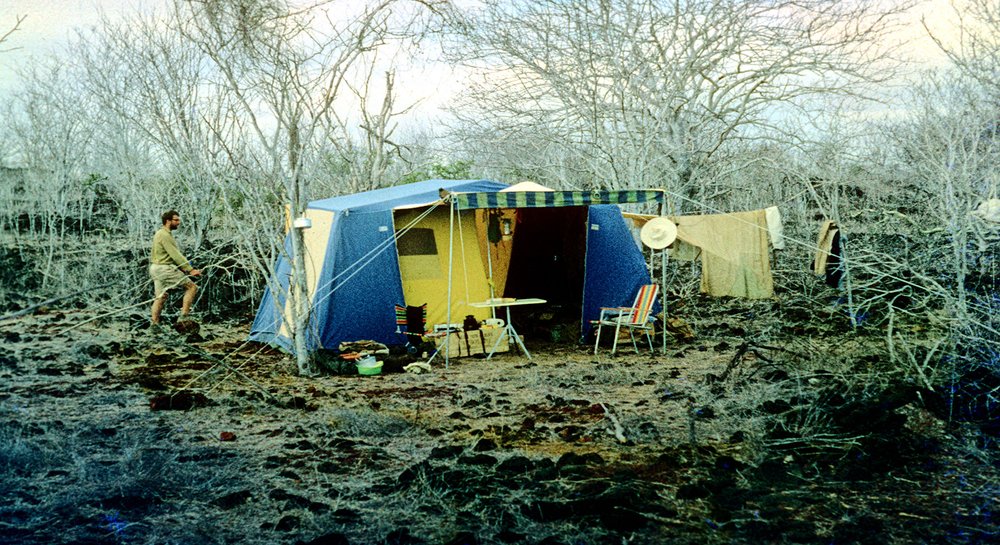
Preparing to go to Galapagos was not easy at that time. In the months leading to my departure, I read a few scientific publications and the very few general introductions to Galapagos available at the time. Of course, there was Darwin’s descriptions of that unfriendly, even hostile landscape and the very special animals. But beyond that there was only Eibl-Eibesfeldt’s and Christian Zuber’s books. I also got hold of William Beebe’s description of what he called the “World’s End”, published in 1924, still in print today and still an excellent read because it provides a raw impression of the special character and the harsh inhospitality of the islands.
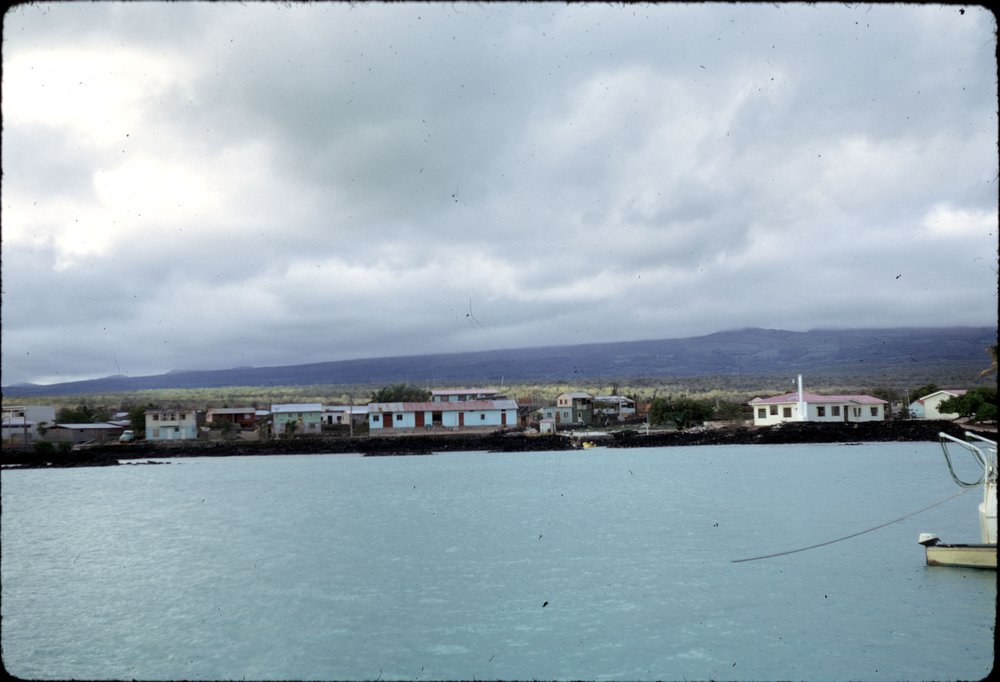
I finished my third semester at the University of Heidelberg, left Hamburg on board a banana freighter in early July and arrived in Guayaquil after almost three weeks, crossing the Atlantic, the Caribbean and the Panama Canal. In Guayaquil, information on when to go to Galapagos was only available on board the ship going there, the “Cristobal Carrier”, a retired WWII army landing craft, anchored on a dock right on the Malecon. The “Cristobal Carriers” generally left on the first Friday of each month, but in reality, it had no fixed schedule. It left whenever there was enough cargo to make the trip worthwhile. It had just returned from Galapagos, so we spent a month in and around Guayaquil, took a bus to the beaches north of Salinas and the train up to Riobamba and finally boarded the “Cristobal Carrier” in early September, arriving on Galapagos more than two months after having left home.
The “Cristobal Carrier” always went to Puerto Baquerizo first, then to Puerto Ayora and finally, if there was any cargo for those destinations, to Puerto Villamil and sometimes to Floreana. We got our first impression of Galapagos on San Cristobal. We had a few hours, so we hired the only car in town to go up to Progreso, where we started to try to identify Darwin’s Finches. This car was not only the only one in town, it was the only car on Galapagos, at the time.
In Puerto Ayora we were received with great hospitality. Curio had communicated with Miguel Castro, a local fisherman and landowner, and asked him to be our host and guide on the Islands. On our arrival, he met us on board and invited us for dinner. He also made sure all our equipment was taken on land and then took us to the place we would rent from him: a two-story house, situated where later the Parque San Francisco, the central plaza of downtown Puerto Ayora, was constructed. We were very lucky. Miguel was intimately familiar with the Islands and had taught himself English. He had guided and shipped around previous visitors, scientists and filmmakers, and had benefited from their biological knowledge. Without his unusual capability as a skipper, naturalist guide and fisherman we would not have been able to do our research during that year.
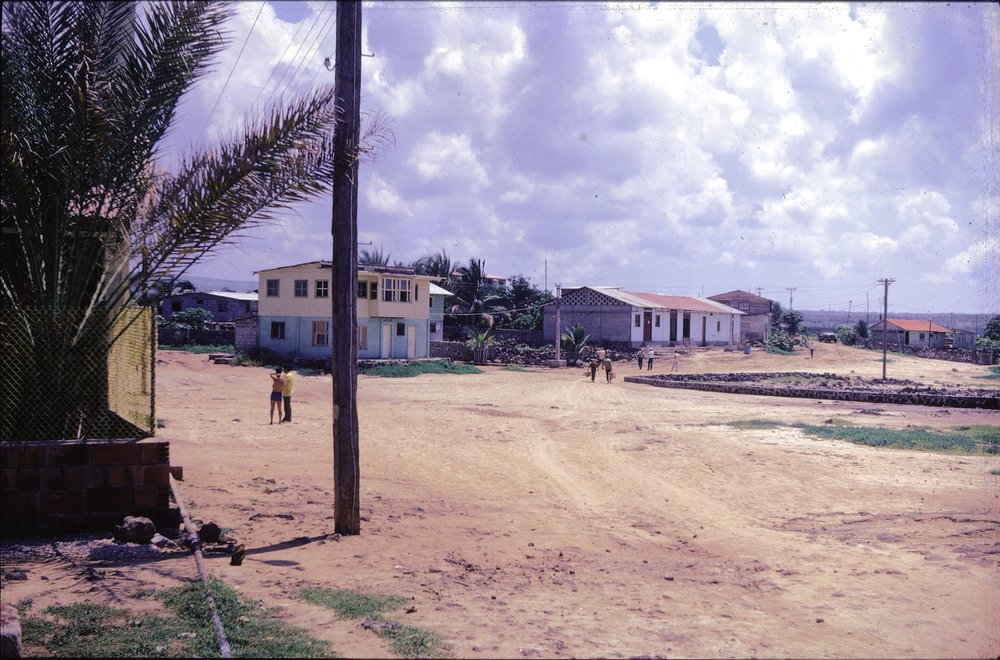
The Darwin Research, which consisted of only two buildings at the time and was known in the village as “La UNESCO”, could be reached by a footpath or by boat. The Director, André Brosset, had arrived recently, replacing Raymond Lévêque, the first Director who had overseen the construction of those two buildings, the “Lab” and the workshop. We stored all our equipment in the Lab, which was also where the Director lived. It is the building where today development and communication staff works. The Research was formally inaugurated two years later.
We spent most of our 12 months on Galapagos camping all over the Archipelago. Miguel took us to northern Santa Cruz, Fernandina, Isabela, Floreana, Pinta, Genovesa, Wolf Island, Santiago and Española. We mainly worked on Wolf, Genovesa, northern Santa Cruz and Pinta. These islands became our home for 6 to 10 weeks each. The focus of our studies was the Darwin’s Finches’ ability to recognize predators. On Galapagos and everywhere else in the world small birds are preyed upon by predators like hawks, owls and snakes. Every bird watcher knows that these small birds everywhere can tell these predators apart from any other animal or object, showing a spontaneous and immediate reaction. Very distinct movements and calls, but also spells of motionlessness, show that recognition. We wanted to find out whether finches learn through experience that these predators are very dangerous or whether they recognize them as mortal enemies spontaneously, without ever having had any encounter with them. To answer that question, we compared the behavior of birds coexisting with predators with birds who have never seen any, but are suddenly confronted with one. The challenge is that it is hard to find birds, who with certainty never experienced a predator. Almost all small bird populations in the world coexist with such dangerous enemies. On Galapagos, however, you have a unique situation; finches live on all islands and on most of them they are constantly exposed to predators. Only on a few small islands they live carefree; On Darwin and Wolf they live without any predators, on Genovesa without hawks and on Pinta without snakes. So, our question was: Do finches that have never experienced such a predator, recognize a hawk, an owl and a snake as being dangerous?
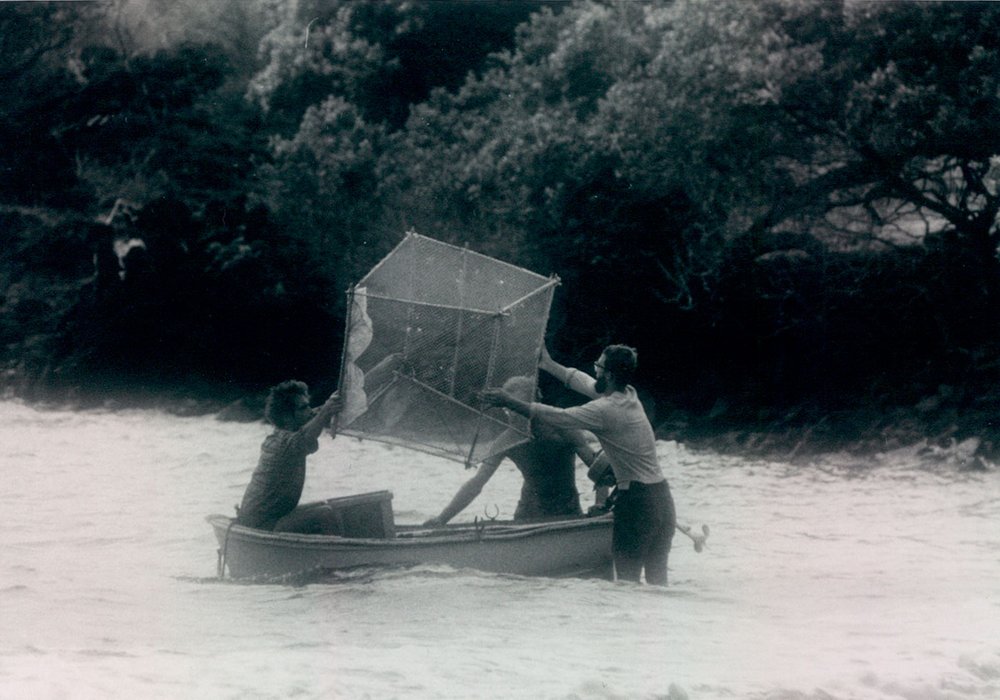
We first worked with finches close to the Darwin Research and on Playa Borrero in northern Santa Cruz and developed our methodology to assess the strength of the finches’ response to a predator. To do that we showed them a series of dummies. They were confronted with a stuffed owl, a stuffed hawk, a stuffed pigeon, a stuffed sock, a large flashlight, or a silicone snake that could be moved from afar. The finch would focus on the dummy and, as many small birds do when looking intensely at something, turn its head from side to side. The frequency of this switching from focusing with one eye to focusing with the other eye can be taken as a rough measure of excitement of the bird, particularly when it is accompanied by warning calls.
In order to obtain valid results, we exposed hundreds of birds to these dummies. Some birds were tested simply where they lived, others we kept in cages when they were tested. Tests on Sta Cruz and Pinta gave us a baseline for the reaction intensity towards hawks and owls. These finches, who coexisted with these predators, reacted clearly and strongly to the dummies, even when they were shown only an owl’s head. The pigeon, the sock and the flashlight excited them briefly, but they quickly lost interest. The reaction to a predator was stronger and lasted much longer. Was this because they had experienced them as being dangerous? Or was it because they had an innate capability to recognize them as being dangerous? To find an answer, we had to test finches who lived without any predators – and that is why we went to Wolf for six and to Genovesa ten weeks.
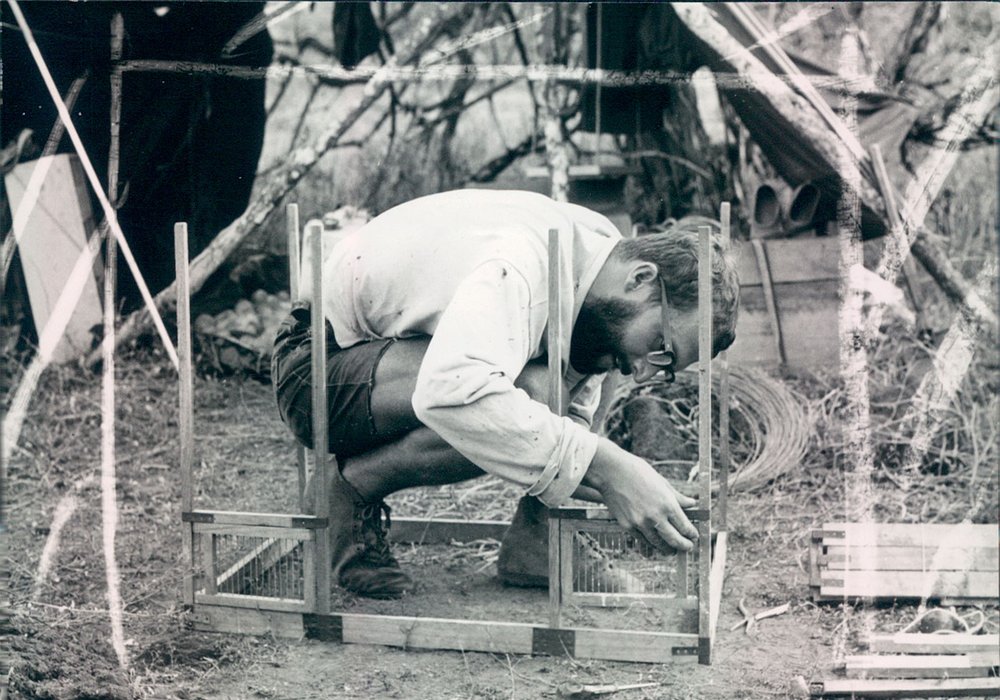
Camping and working on Wolf was the roughest experience we had. After a two-day trip on Miguel’s tough little boat, the “Odin”, we reached Wolf on January 6, 1963. Miguel got us to the only place where landing is possible; a steep slope of boulders and rubble on the island’s west side. The heavy surf made unloading our equipment a challenge, but after two days’ work, we had pitched a tarp on a few big boulders close to a cliff, had tied down our battery of water canisters and stored part of our equipment under an overhang of the cliff. We were worried about big waves possibly washing away our supplies, but moving further uphill was impossible; it was too steep.
We started working successfully with the Wolf finches, but our work was interrupted by a totally unexpected event. Miguel had just brought us fresh supplies after our first three weeks, when heavy Niño season rain started coming down. It hit us late in the evening. The sound of a few heavy drops drumming down on our tent quicky turned into a massive downpour. At first, we were not worried. Everything was stored in dry places either under the tarp or under the overhang. But then we were startled by a different sound. The swooshing of the heavy rain started to be accompanied by a rumbling reminding me of a freight train. That freight train came from uphill and the rumbling grew into a roar. We realized what was happening when first a trickle and then a fast-growing mass of mud pushed into our tarp. We grabbed the most important pieces of equipment and a few food items and brought them into the overhang, which now was reachable only through a waterfall cascading from the cliff. We managed to rescue part of our equipment and a bag of sugar that had been partly open. After a couple of rescue trips back and forth our tarp became totally submerged and was crushed down by the swelling mass of mud and rocks, taking trees and bushes and even dying and shrieking red-footed boobies along. We spent the night in the overhang and saw in the morning that the land uphill had changed: we had witnessed natural erosion in action and were lucky to have avoided the boobies’ fate.
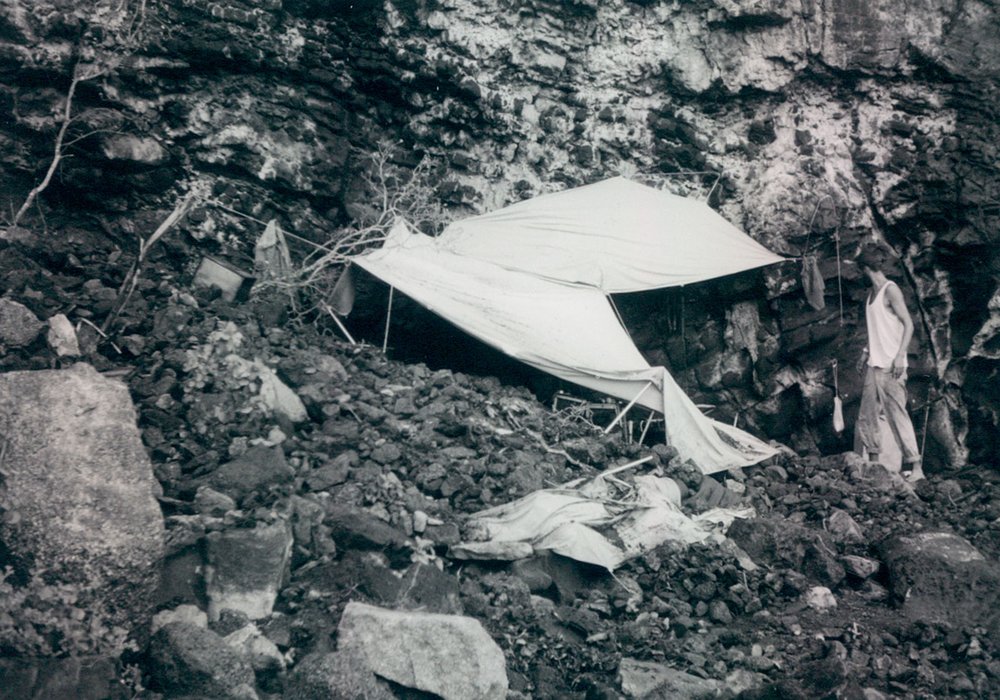
We spent a couple of days digging out our tarp and the equipment that had not been swept into the sea. Fortunately, we had not lost any of our fresh water supply, which was safely tied up. This was very lucky because two days later we were hit by a massive spring tide, which ironically washed up some of our lost equipment in altered state. We were blessed with enough fresh water and we also had a few cans of food, ironically mostly tuna. Of course, we needed more food. And we were lucky; among the items that were not washed down into the sea we retained nylon string, a fishing hook, a diving mask and the rope that secured the fresh water. We started fishing and were pretty successful at first. But we soon lost that source of food when a good-sized grouper that I had pulled in carefully was torn off by a big shark with our only hook and part of the line. Curio and I did not discuss it, but I was reminded of dramatic stories of people shipwrecked on Galapagos, as told by William Beebe. Before trying to kill and eat fur seals or sea birds as those unfortunate people had done, we started making use of the diving mask and explored possibilities under water. The surf was rough, so I tied myself to our rope, which my boss held on to, and dove in at low tide. I quickly discovered that several caves in the underwater cliff served as over-day homes of countless lobsters. I found that they piled up by the dozens in each cave, protecting themselves by sticking out their spiky antennae. It took time and practice to carefully grab the antennae of one individual lobster, pull it out and hold it with both hands while swimming back through the surf to the rocks.
Fish and lobster are great food, but they are hard to digest uncooked. Our cooking equipment had gone, except for one or two aluminum pots washed up by the tide. Also, all our matches had been destroyed. It took us a few hours of trial-and-error research to find a way to light a fire. It involved a binocular lens (which had gotten wet, but was carefully dried out), paper (which had to be dried) and gunpowder (we had a gun and ammunition to shoot goats where they were found). We screwed off a binocular lens, distributed gunpowder on a piece of paper and set it on fire with the help of the lens. All that was needed was sun to hit the lens, wood to maintain a fire and salt water to cook the lobster – and there was an endless supply of all three. As a result, we ate lobster three times a day for more than two weeks, sometimes refined with some dirty sugar.
Once we had reoriented ourselves, tied up our rescued tarp against the cliff and carefully cleaned our dummies, we resumed our work. The finches obviously were unfazed. The breeding season was on. They were singing and building nests and food was plentiful. We found that on Wolf they were particularly versatile, feeding on anything they found in the surf and quickly focusing on parts of fish that the Red-footed Boobies would drop below their nest when feeding their young. Once it got dark, if the finches had not finished off those pieces of fish the enormous centipedes cleaned them off. A few years later others discovered that our finches, the Wolf Sharp-beaked Finches, also had the blood of Nazca Boobies on their menu. Consequently, they were baptized “Vampire Finches”. We missed that behavior, probably because we only once climbed up to the higher parts of Wolf, which is where the Nazca Boobies breed. When Miguel picked us up on February 17, we had lost weight and were craving fruit and vegetables, but we had done our finch experiments as planned.
During our ten weeks on Genovesa we camped much more comfortably, right on the Darwin Bay beach. We tested and got to know about 100 finches, a large proportion of the finch population living in the Darwin Bay area. They certainly had never seen a hawk and probably never a Short-Eared Owl. The Genovesa owls live and nest in the storm petrel colonies. They are highly specialized petrel hunters and seem to hardly ever leave the area where their prey nests.
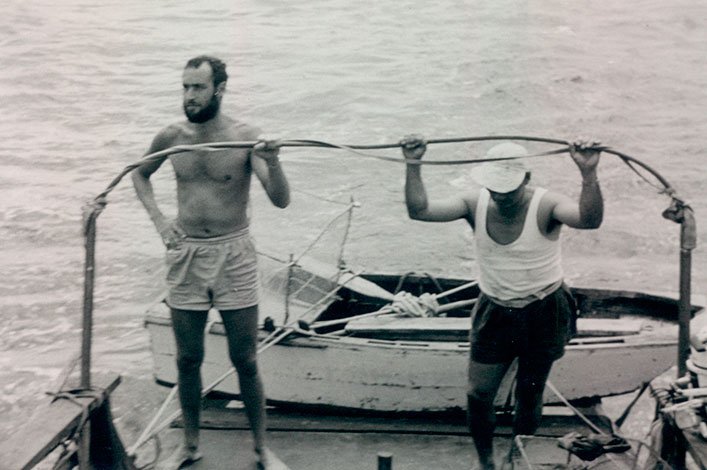
Miguel Castro brought us fresh supplies twice and we had no other visitors during those ten weeks - except David Balfour who had just arrived on his yacht “Lucent” and whom we hired as a helper for a while. Living as a two-person team in isolation as we did was challenging, but we managed to achieve what we set out to do, partly because we kept fixed work hours and had clearly defined duties within a simple hierarchy: Curio was the boss, I was the assistant. Our working hours were filled with everything that needed to be done to carry out our finch experiments and to feed ourselves. But we also allowed ourselves free time. We filled that free time with observations of other animals we saw on any rocky shore and whose behavior fascinated us. Curio had fun following the Four-eyed Blenny and I focused on the Sally Lightfoot Crab. Both of us later published papers on these extraordinary Galapagos animals, in addition to the results on the finches. In the course of those ten weeks there was also time for leisure and exploring. We went to the Storm Petrel colony to check on the owl pellets and to the caldera to see the lake. The excursion to that caldera took unexpectedly long, even though it is only about a kilometer away from Darwin Bay, because of the cliffs that are in the way and the typically difficult terrain. Once there the view of that blue lake was a wonderful reward: a massive amphitheater enlivened by the concert of echoing frigate bird and booby calls.
Back on that wonderful beach in Darwin Bay I spent many evenings around sunset watching these two fascinating birds interact: The Red-footed Boobies, returning from their fishing tour were met by waiting Frigate Birds circling high up. The boobies, expecting an attack, sped up, trying to escape the frigates who dove down and chased and harassed them at high speed, sometimes catching them by a tail feather and pulling them up for a little while. The boobies screamed and tried to escape, but often disgorged at least part of the catch intended for their young. The skillful frigates caught what the boobies spewed out either directly from their bill or in the air as it dropped. Almost never did it fall into the sea. If it did, the frigates scooped it up flying over it, with an elegant backward swing of their bill. They also pursued Tropic Birds, but they escaped with great speed. I never saw them lose their catch.
So, what did we find? Do Darwin’s Finches recognize owls, hawks and snakes as being life threatening enemies, even without ever having seen or experienced them? The short answer is yes, they do. They examine anything they are not used to, but fairly quickly lose interest in a stuffed sock, a stuffed pigeon or a big flashlight. Not so when they are confronted with any one of those three predators. Finches co-existing with them, as well as those that have never experienced them and whose ancestors have also not experienced them for many generations, show a distinct and prolonged reaction. The reaction of these unexperienced finches is somewhat weaker, but still distinct and prolonged. It seems that in the course of evolution small birds have acquired the innate capacity to recognize and react to predators. But when there is no predator to select for such spontaneous recognition and reaction, that capacity seems to become less pronounced.
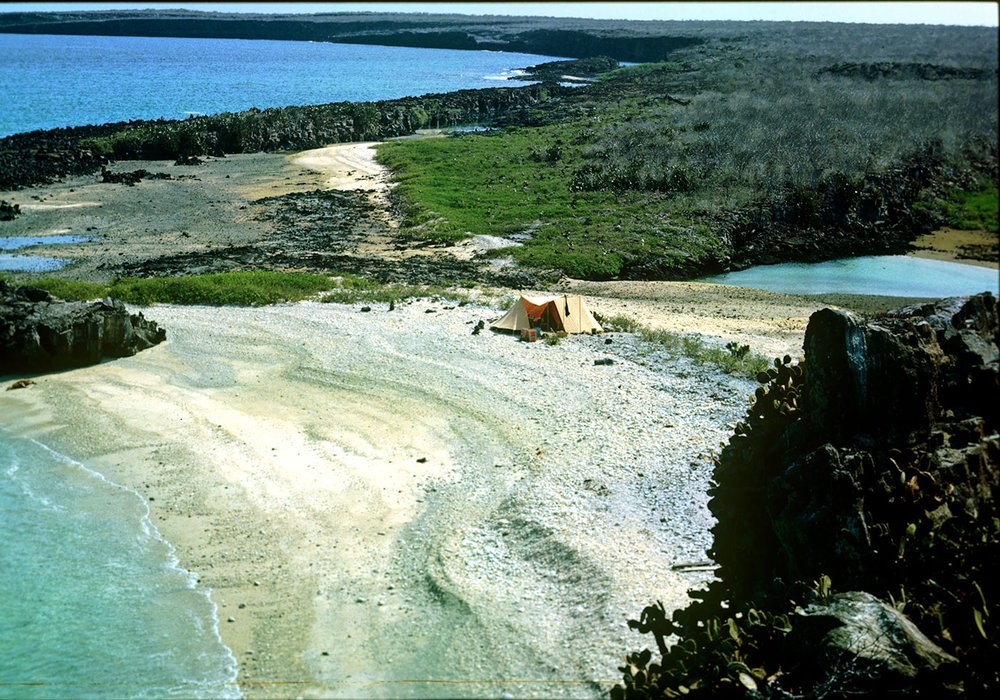
At the end of our year on Galapagos, I considered remaining. I thought of finding a grant to continue observing Sally Lightfoots and maybe finding some other type of work. Galapagos had me under its spell - and it still does. But reason prevailed. I started to comprehend that, even though I was qualified to live by myself on an island, broader studies and academic degrees would help me be more effective, on Galapagos and elsewhere. I left Galapagos in September 1963, returned to Germany, again on a banana freighter, and resumed my university studies with a clearer understanding what it was all about. I returned to Galapagos seven years later to serve as Darwin Research Director.





